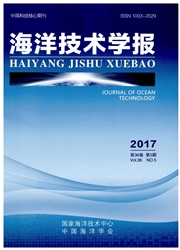

 中文摘要:
中文摘要:
锚泊基础的承载性能直接影响着海洋浮式结构物的稳定性,因而研究新型有效的锚泊基础已成为海洋工程结构设计中的关键问题之一。文中提出了一种基于海洋软土液化特性的伞状锚,充分利用桩端土体增强抗拔承载能力。应用二维颗粒流分析程序,对该新型伞状锚的安装、抗拔承载能力进行了数值模拟,并与普通锚桩进行比较分析,验证其有效性。针对伞状锚与普通锚桩在拉拔过程中的土体破坏机制,从细观角度分析了其抗拔承载能力的提高机制。研究结果表明,对于相同抗拔锚泊设计竖向承载要求,伞状锚所需材料可大为减少,安装难度明显减低,是值得推广应用的新型锚泊基础形式。
 英文摘要:
英文摘要:
The bearing capacity of anchor foundations directly affects the stability of marine floating structures, so it is a critical issue to study novel anchoring techniques with higher performance in the design of marine engineering structures. Based on the sandy soil behavior of liquefaction under cyclical loading, a novel umbrella-shaped anchor(NUSA) is proposed to improve the bearing capacity by taking advantage of the soil at the bottom end of the anchor pile. The installation and bearing capacity of NUSA are investigated by using two-dimensional numerical particle flow programs, and the efficiency of NUSA is verified by comparing with that of traditional anchor pile. The improved bearing capacity is analyzed from the microscopic prospect by comparing the difference between the soil failure mechanism around the NUSA and that of the traditional anchor pile. The results show that the material cost and installation difficulty can be reduced drastically with the use of umbrella-shaped anchor under the same bearing capacity. It is beneficial to study and apply the technique of NUSA in marine engineering.
 同期刊论文项目
同期刊论文项目
 同项目期刊论文
同项目期刊论文
 期刊信息
期刊信息
